Australia Day Event: A Comprehensive Analysis of Cultural Significance
VerifiedAdded on 2023/06/14
|8
|1635
|67
Report
AI Summary
This report provides a detailed overview of the Australia Day event, celebrated annually on January 26th in Australia. It delves into the event's cultural significance, highlighting its importance in celebrating Australian citizenship, values, and national identity. The report describes the various ceremonies associated with the day, including citizenship ceremonies, affirmation ceremonies, and flag-raising ceremonies. It also examines the goals and objectives of the event, emphasizing its role in promoting national unity and cultural pride. Furthermore, the report outlines the staging of the event, including the organizations involved, the programs offered, and the typical venues and timings. Additional entertainment aspects such as fireworks, concerts, and sports activities are also discussed, along with basic marketing strategies employed to promote the event. Finally, the report touches upon some of the social issues surrounding Australia Day, particularly regarding its historical context and its impact on indigenous populations. The report concludes by emphasizing the importance of Australia Day in fostering a sense of community and upholding the values of Australian society. Desklib offers a variety of solved assignments and past papers for students.
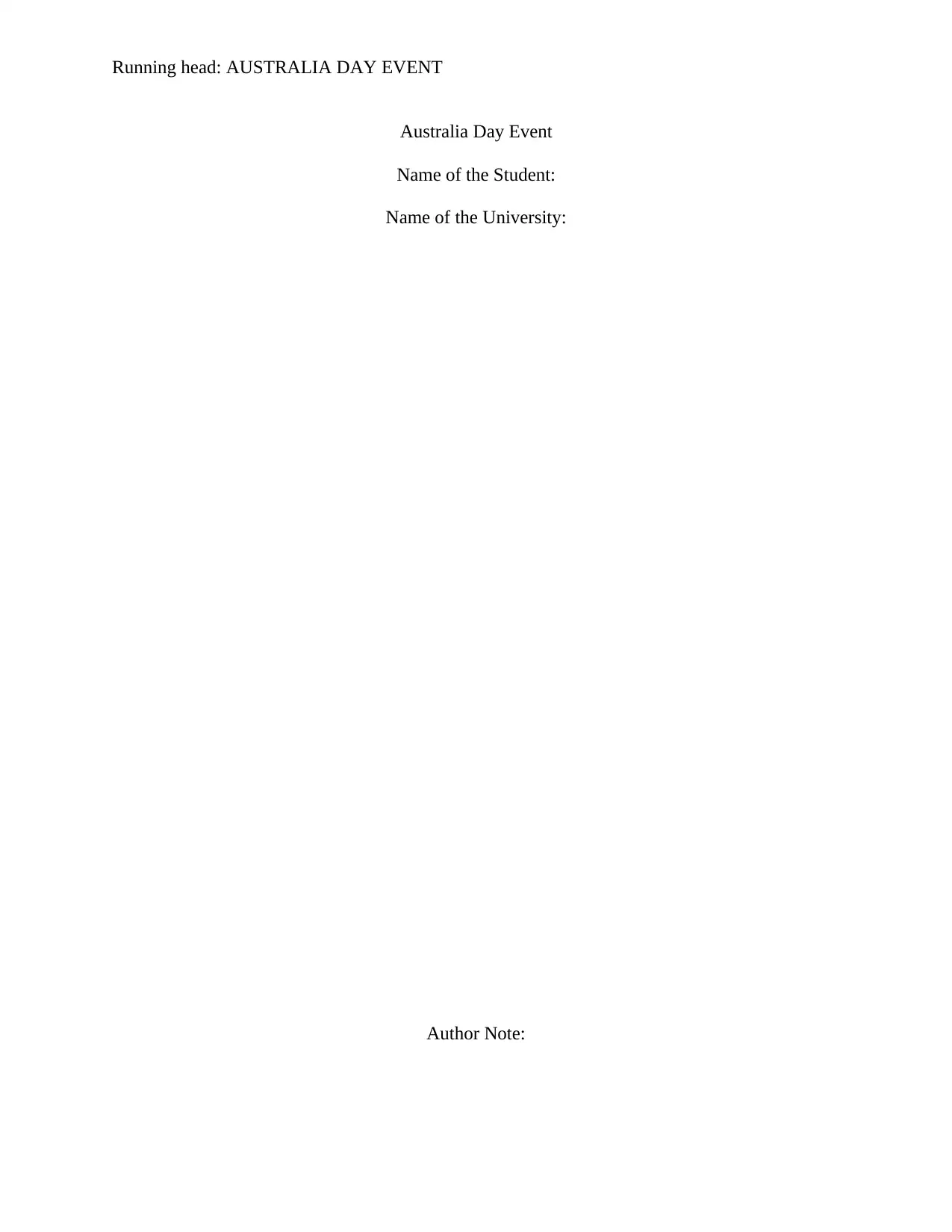
Running head: AUSTRALIA DAY EVENT
Australia Day Event
Name of the Student:
Name of the University:
Author Note:
Australia Day Event
Name of the Student:
Name of the University:
Author Note:
Paraphrase This Document
Need a fresh take? Get an instant paraphrase of this document with our AI Paraphraser
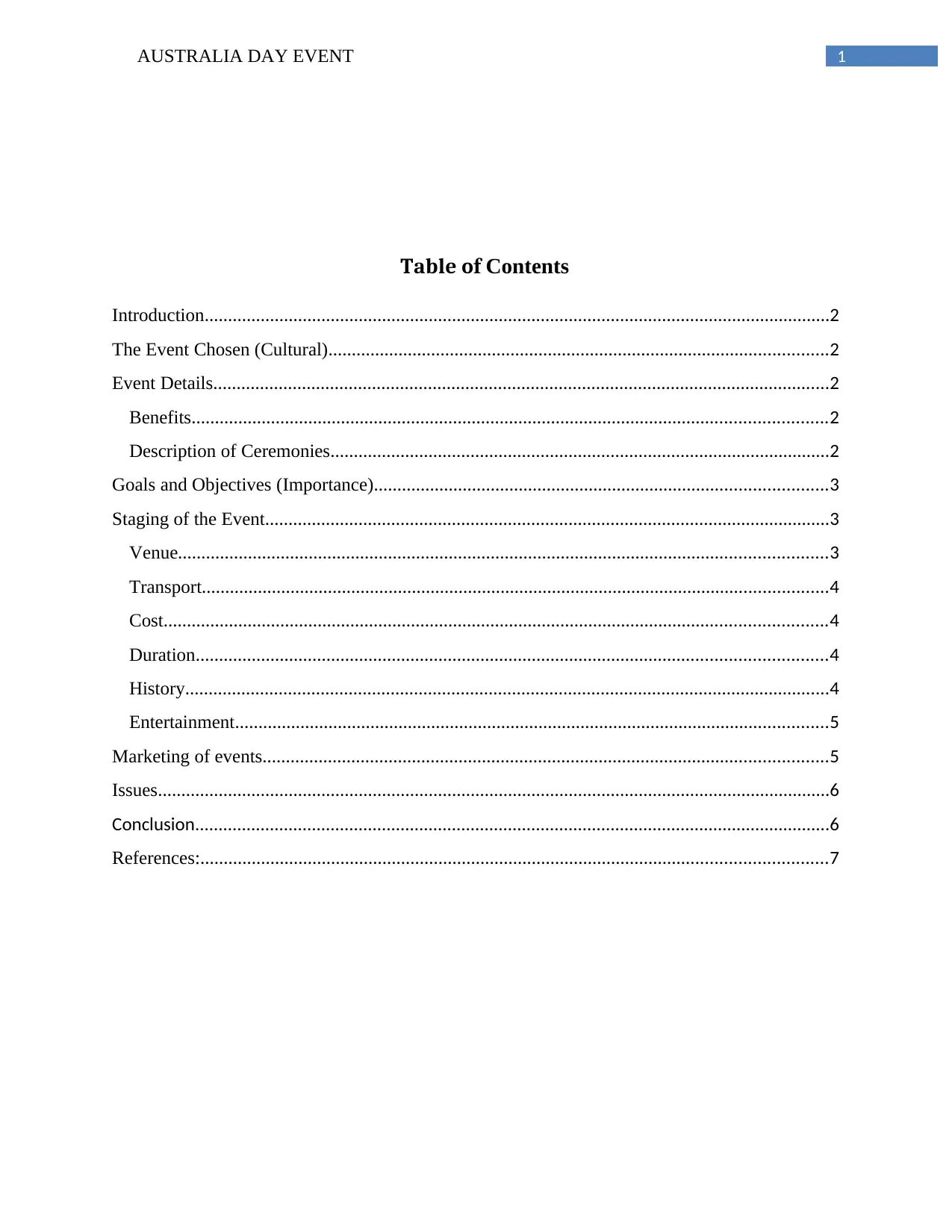
1AUSTRALIA DAY EVENT
Table of Contents
Introduction......................................................................................................................................2
The Event Chosen (Cultural)...........................................................................................................2
Event Details....................................................................................................................................2
Benefits........................................................................................................................................2
Description of Ceremonies...........................................................................................................2
Goals and Objectives (Importance).................................................................................................3
Staging of the Event.........................................................................................................................3
Venue...........................................................................................................................................3
Transport......................................................................................................................................4
Cost..............................................................................................................................................4
Duration.......................................................................................................................................4
History..........................................................................................................................................4
Entertainment...............................................................................................................................5
Marketing of events.........................................................................................................................5
Issues................................................................................................................................................6
Conclusion........................................................................................................................................6
References:......................................................................................................................................7
Table of Contents
Introduction......................................................................................................................................2
The Event Chosen (Cultural)...........................................................................................................2
Event Details....................................................................................................................................2
Benefits........................................................................................................................................2
Description of Ceremonies...........................................................................................................2
Goals and Objectives (Importance).................................................................................................3
Staging of the Event.........................................................................................................................3
Venue...........................................................................................................................................3
Transport......................................................................................................................................4
Cost..............................................................................................................................................4
Duration.......................................................................................................................................4
History..........................................................................................................................................4
Entertainment...............................................................................................................................5
Marketing of events.........................................................................................................................5
Issues................................................................................................................................................6
Conclusion........................................................................................................................................6
References:......................................................................................................................................7
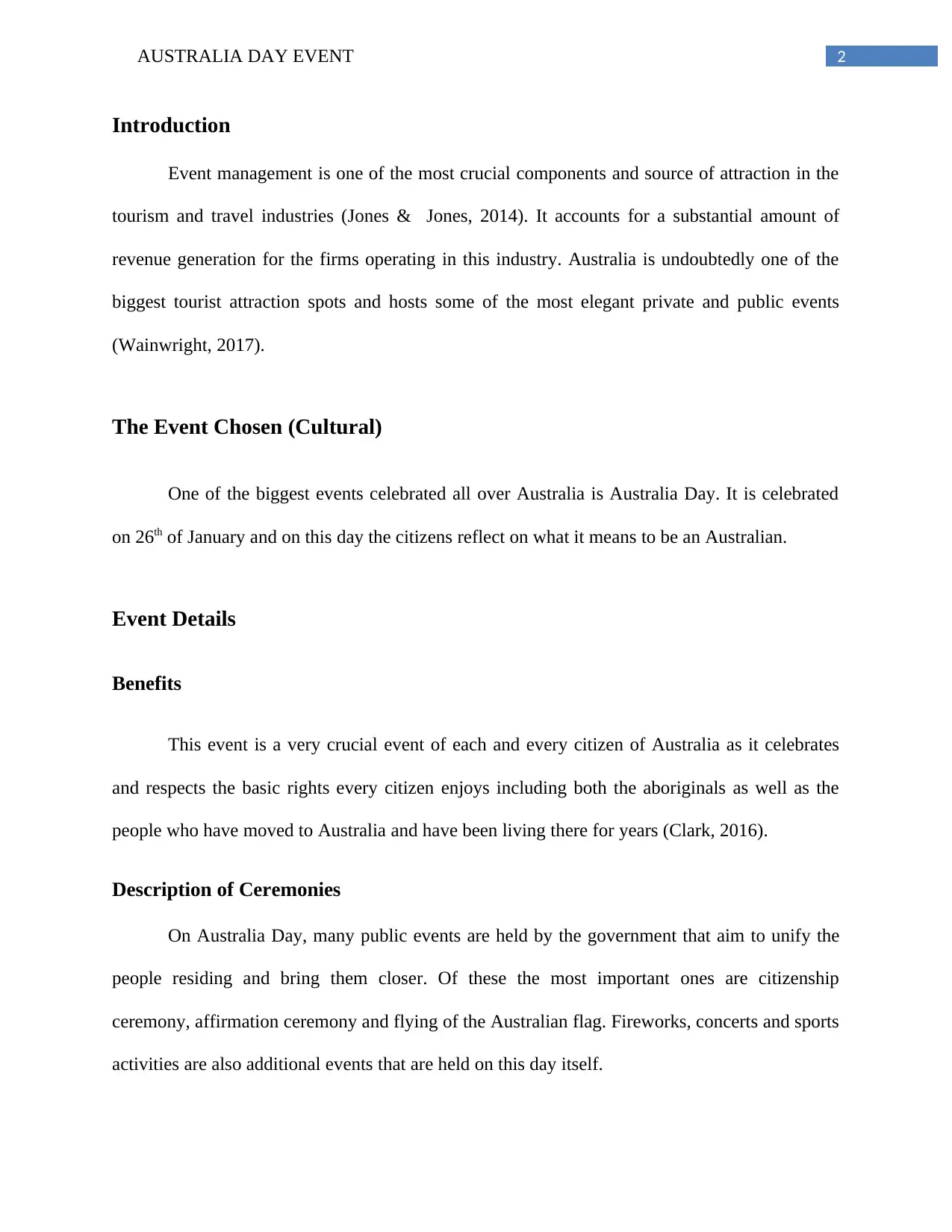
2AUSTRALIA DAY EVENT
Introduction
Event management is one of the most crucial components and source of attraction in the
tourism and travel industries (Jones & Jones, 2014). It accounts for a substantial amount of
revenue generation for the firms operating in this industry. Australia is undoubtedly one of the
biggest tourist attraction spots and hosts some of the most elegant private and public events
(Wainwright, 2017).
The Event Chosen (Cultural)
One of the biggest events celebrated all over Australia is Australia Day. It is celebrated
on 26th of January and on this day the citizens reflect on what it means to be an Australian.
Event Details
Benefits
This event is a very crucial event of each and every citizen of Australia as it celebrates
and respects the basic rights every citizen enjoys including both the aboriginals as well as the
people who have moved to Australia and have been living there for years (Clark, 2016).
Description of Ceremonies
On Australia Day, many public events are held by the government that aim to unify the
people residing and bring them closer. Of these the most important ones are citizenship
ceremony, affirmation ceremony and flying of the Australian flag. Fireworks, concerts and sports
activities are also additional events that are held on this day itself.
Introduction
Event management is one of the most crucial components and source of attraction in the
tourism and travel industries (Jones & Jones, 2014). It accounts for a substantial amount of
revenue generation for the firms operating in this industry. Australia is undoubtedly one of the
biggest tourist attraction spots and hosts some of the most elegant private and public events
(Wainwright, 2017).
The Event Chosen (Cultural)
One of the biggest events celebrated all over Australia is Australia Day. It is celebrated
on 26th of January and on this day the citizens reflect on what it means to be an Australian.
Event Details
Benefits
This event is a very crucial event of each and every citizen of Australia as it celebrates
and respects the basic rights every citizen enjoys including both the aboriginals as well as the
people who have moved to Australia and have been living there for years (Clark, 2016).
Description of Ceremonies
On Australia Day, many public events are held by the government that aim to unify the
people residing and bring them closer. Of these the most important ones are citizenship
ceremony, affirmation ceremony and flying of the Australian flag. Fireworks, concerts and sports
activities are also additional events that are held on this day itself.
⊘ This is a preview!⊘
Do you want full access?
Subscribe today to unlock all pages.

Trusted by 1+ million students worldwide
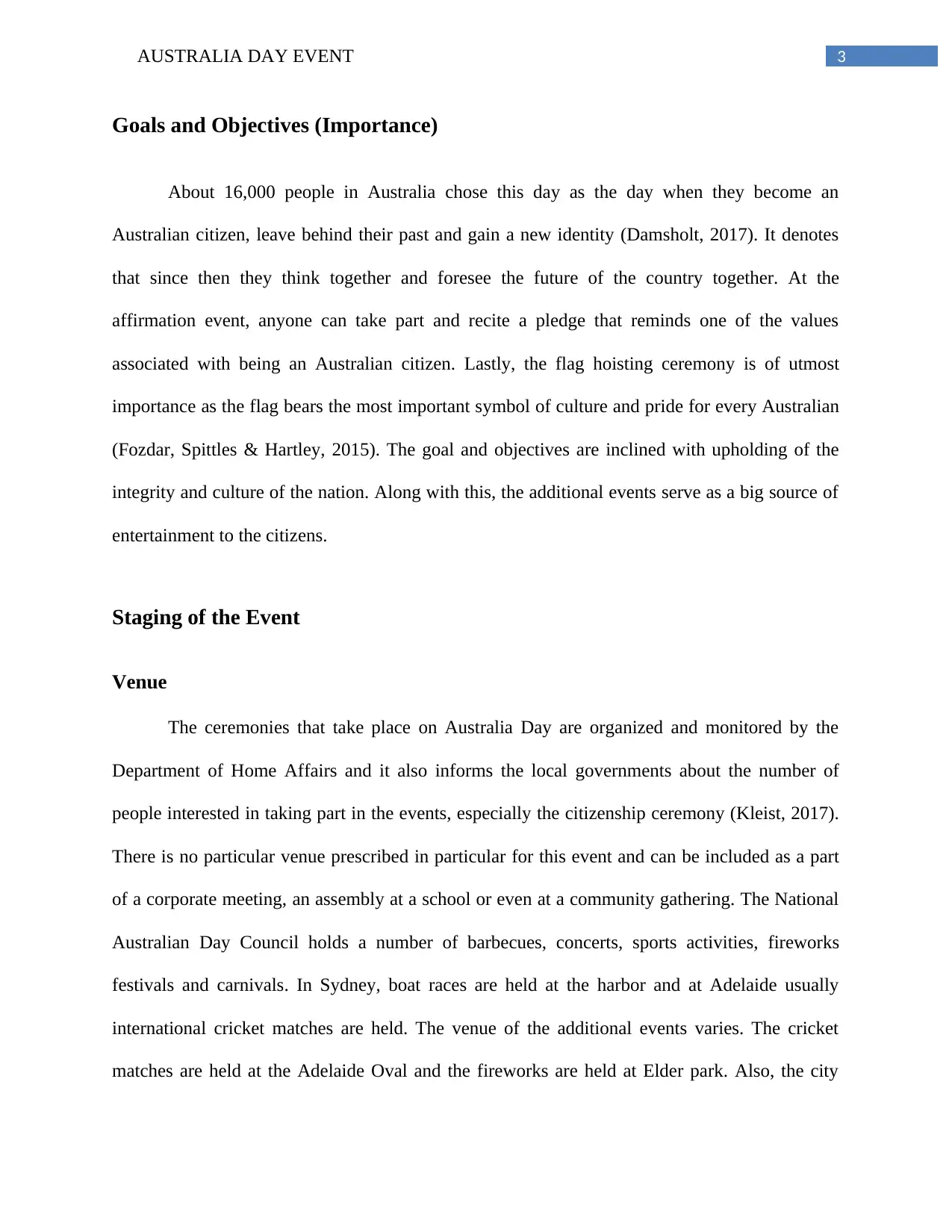
3AUSTRALIA DAY EVENT
Goals and Objectives (Importance)
About 16,000 people in Australia chose this day as the day when they become an
Australian citizen, leave behind their past and gain a new identity (Damsholt, 2017). It denotes
that since then they think together and foresee the future of the country together. At the
affirmation event, anyone can take part and recite a pledge that reminds one of the values
associated with being an Australian citizen. Lastly, the flag hoisting ceremony is of utmost
importance as the flag bears the most important symbol of culture and pride for every Australian
(Fozdar, Spittles & Hartley, 2015). The goal and objectives are inclined with upholding of the
integrity and culture of the nation. Along with this, the additional events serve as a big source of
entertainment to the citizens.
Staging of the Event
Venue
The ceremonies that take place on Australia Day are organized and monitored by the
Department of Home Affairs and it also informs the local governments about the number of
people interested in taking part in the events, especially the citizenship ceremony (Kleist, 2017).
There is no particular venue prescribed in particular for this event and can be included as a part
of a corporate meeting, an assembly at a school or even at a community gathering. The National
Australian Day Council holds a number of barbecues, concerts, sports activities, fireworks
festivals and carnivals. In Sydney, boat races are held at the harbor and at Adelaide usually
international cricket matches are held. The venue of the additional events varies. The cricket
matches are held at the Adelaide Oval and the fireworks are held at Elder park. Also, the city
Goals and Objectives (Importance)
About 16,000 people in Australia chose this day as the day when they become an
Australian citizen, leave behind their past and gain a new identity (Damsholt, 2017). It denotes
that since then they think together and foresee the future of the country together. At the
affirmation event, anyone can take part and recite a pledge that reminds one of the values
associated with being an Australian citizen. Lastly, the flag hoisting ceremony is of utmost
importance as the flag bears the most important symbol of culture and pride for every Australian
(Fozdar, Spittles & Hartley, 2015). The goal and objectives are inclined with upholding of the
integrity and culture of the nation. Along with this, the additional events serve as a big source of
entertainment to the citizens.
Staging of the Event
Venue
The ceremonies that take place on Australia Day are organized and monitored by the
Department of Home Affairs and it also informs the local governments about the number of
people interested in taking part in the events, especially the citizenship ceremony (Kleist, 2017).
There is no particular venue prescribed in particular for this event and can be included as a part
of a corporate meeting, an assembly at a school or even at a community gathering. The National
Australian Day Council holds a number of barbecues, concerts, sports activities, fireworks
festivals and carnivals. In Sydney, boat races are held at the harbor and at Adelaide usually
international cricket matches are held. The venue of the additional events varies. The cricket
matches are held at the Adelaide Oval and the fireworks are held at Elder park. Also, the city
Paraphrase This Document
Need a fresh take? Get an instant paraphrase of this document with our AI Paraphraser
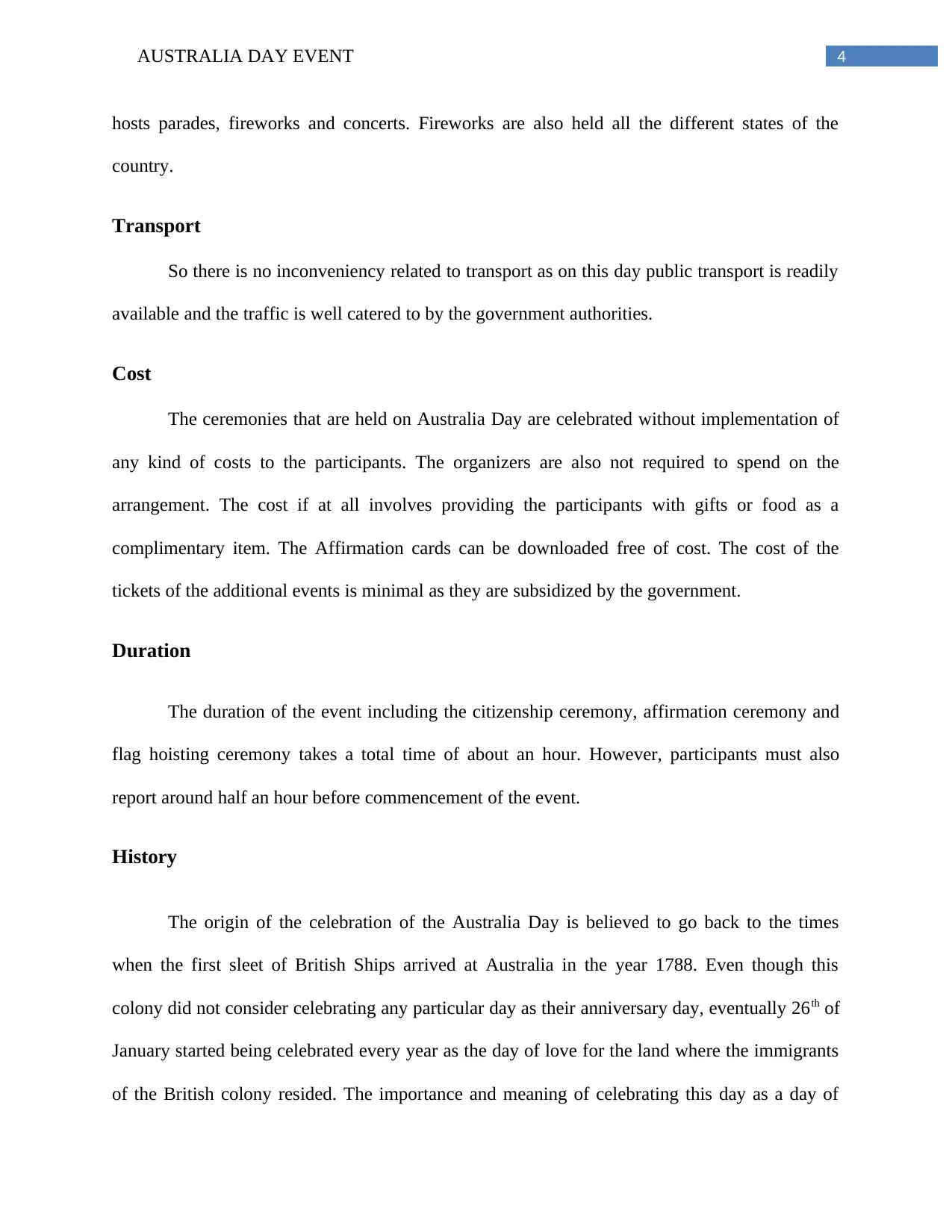
4AUSTRALIA DAY EVENT
hosts parades, fireworks and concerts. Fireworks are also held all the different states of the
country.
Transport
So there is no inconveniency related to transport as on this day public transport is readily
available and the traffic is well catered to by the government authorities.
Cost
The ceremonies that are held on Australia Day are celebrated without implementation of
any kind of costs to the participants. The organizers are also not required to spend on the
arrangement. The cost if at all involves providing the participants with gifts or food as a
complimentary item. The Affirmation cards can be downloaded free of cost. The cost of the
tickets of the additional events is minimal as they are subsidized by the government.
Duration
The duration of the event including the citizenship ceremony, affirmation ceremony and
flag hoisting ceremony takes a total time of about an hour. However, participants must also
report around half an hour before commencement of the event.
History
The origin of the celebration of the Australia Day is believed to go back to the times
when the first sleet of British Ships arrived at Australia in the year 1788. Even though this
colony did not consider celebrating any particular day as their anniversary day, eventually 26th of
January started being celebrated every year as the day of love for the land where the immigrants
of the British colony resided. The importance and meaning of celebrating this day as a day of
hosts parades, fireworks and concerts. Fireworks are also held all the different states of the
country.
Transport
So there is no inconveniency related to transport as on this day public transport is readily
available and the traffic is well catered to by the government authorities.
Cost
The ceremonies that are held on Australia Day are celebrated without implementation of
any kind of costs to the participants. The organizers are also not required to spend on the
arrangement. The cost if at all involves providing the participants with gifts or food as a
complimentary item. The Affirmation cards can be downloaded free of cost. The cost of the
tickets of the additional events is minimal as they are subsidized by the government.
Duration
The duration of the event including the citizenship ceremony, affirmation ceremony and
flag hoisting ceremony takes a total time of about an hour. However, participants must also
report around half an hour before commencement of the event.
History
The origin of the celebration of the Australia Day is believed to go back to the times
when the first sleet of British Ships arrived at Australia in the year 1788. Even though this
colony did not consider celebrating any particular day as their anniversary day, eventually 26th of
January started being celebrated every year as the day of love for the land where the immigrants
of the British colony resided. The importance and meaning of celebrating this day as a day of
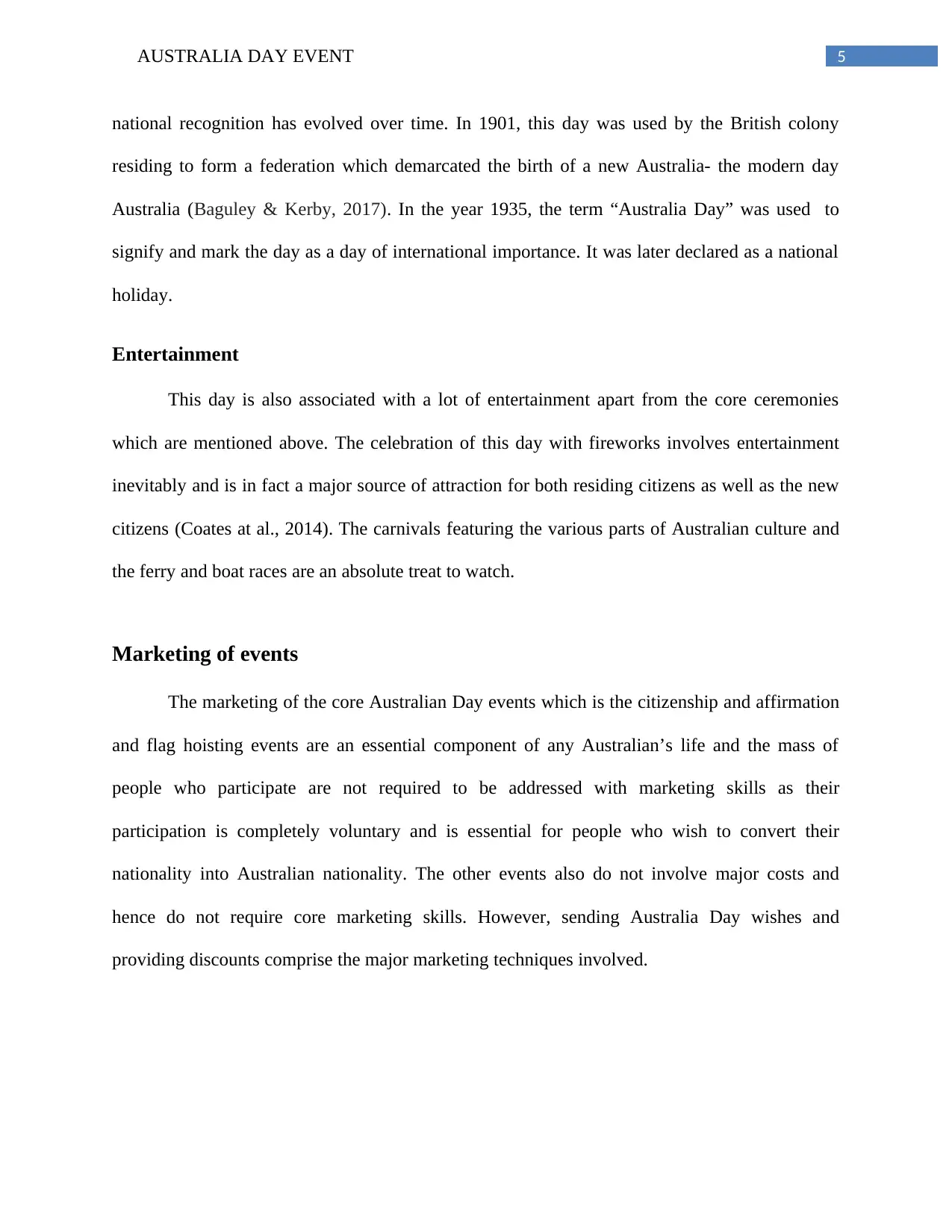
5AUSTRALIA DAY EVENT
national recognition has evolved over time. In 1901, this day was used by the British colony
residing to form a federation which demarcated the birth of a new Australia- the modern day
Australia (Baguley & Kerby, 2017). In the year 1935, the term “Australia Day” was used to
signify and mark the day as a day of international importance. It was later declared as a national
holiday.
Entertainment
This day is also associated with a lot of entertainment apart from the core ceremonies
which are mentioned above. The celebration of this day with fireworks involves entertainment
inevitably and is in fact a major source of attraction for both residing citizens as well as the new
citizens (Coates at al., 2014). The carnivals featuring the various parts of Australian culture and
the ferry and boat races are an absolute treat to watch.
Marketing of events
The marketing of the core Australian Day events which is the citizenship and affirmation
and flag hoisting events are an essential component of any Australian’s life and the mass of
people who participate are not required to be addressed with marketing skills as their
participation is completely voluntary and is essential for people who wish to convert their
nationality into Australian nationality. The other events also do not involve major costs and
hence do not require core marketing skills. However, sending Australia Day wishes and
providing discounts comprise the major marketing techniques involved.
national recognition has evolved over time. In 1901, this day was used by the British colony
residing to form a federation which demarcated the birth of a new Australia- the modern day
Australia (Baguley & Kerby, 2017). In the year 1935, the term “Australia Day” was used to
signify and mark the day as a day of international importance. It was later declared as a national
holiday.
Entertainment
This day is also associated with a lot of entertainment apart from the core ceremonies
which are mentioned above. The celebration of this day with fireworks involves entertainment
inevitably and is in fact a major source of attraction for both residing citizens as well as the new
citizens (Coates at al., 2014). The carnivals featuring the various parts of Australian culture and
the ferry and boat races are an absolute treat to watch.
Marketing of events
The marketing of the core Australian Day events which is the citizenship and affirmation
and flag hoisting events are an essential component of any Australian’s life and the mass of
people who participate are not required to be addressed with marketing skills as their
participation is completely voluntary and is essential for people who wish to convert their
nationality into Australian nationality. The other events also do not involve major costs and
hence do not require core marketing skills. However, sending Australia Day wishes and
providing discounts comprise the major marketing techniques involved.
⊘ This is a preview!⊘
Do you want full access?
Subscribe today to unlock all pages.

Trusted by 1+ million students worldwide
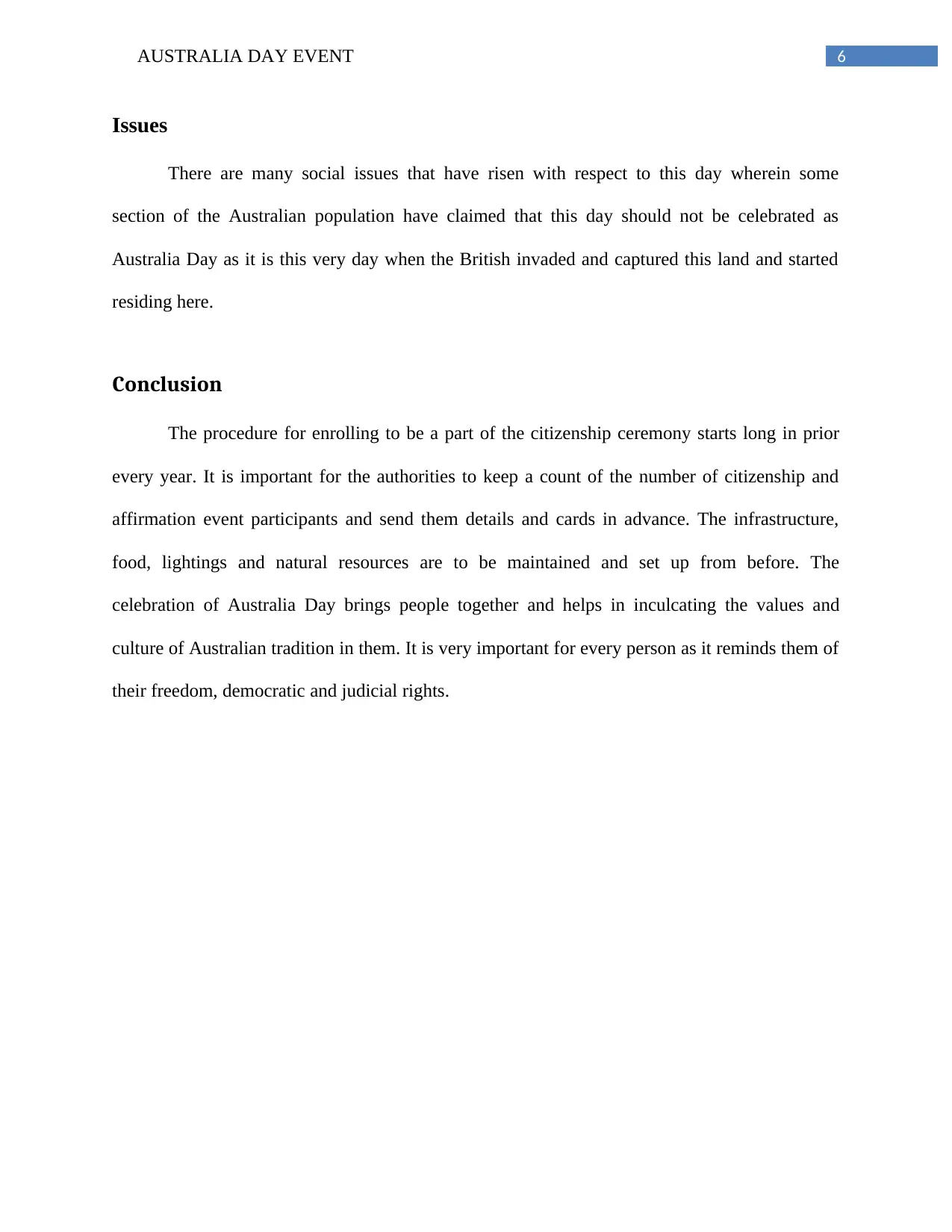
6AUSTRALIA DAY EVENT
Issues
There are many social issues that have risen with respect to this day wherein some
section of the Australian population have claimed that this day should not be celebrated as
Australia Day as it is this very day when the British invaded and captured this land and started
residing here.
Conclusion
The procedure for enrolling to be a part of the citizenship ceremony starts long in prior
every year. It is important for the authorities to keep a count of the number of citizenship and
affirmation event participants and send them details and cards in advance. The infrastructure,
food, lightings and natural resources are to be maintained and set up from before. The
celebration of Australia Day brings people together and helps in inculcating the values and
culture of Australian tradition in them. It is very important for every person as it reminds them of
their freedom, democratic and judicial rights.
Issues
There are many social issues that have risen with respect to this day wherein some
section of the Australian population have claimed that this day should not be celebrated as
Australia Day as it is this very day when the British invaded and captured this land and started
residing here.
Conclusion
The procedure for enrolling to be a part of the citizenship ceremony starts long in prior
every year. It is important for the authorities to keep a count of the number of citizenship and
affirmation event participants and send them details and cards in advance. The infrastructure,
food, lightings and natural resources are to be maintained and set up from before. The
celebration of Australia Day brings people together and helps in inculcating the values and
culture of Australian tradition in them. It is very important for every person as it reminds them of
their freedom, democratic and judicial rights.
Paraphrase This Document
Need a fresh take? Get an instant paraphrase of this document with our AI Paraphraser
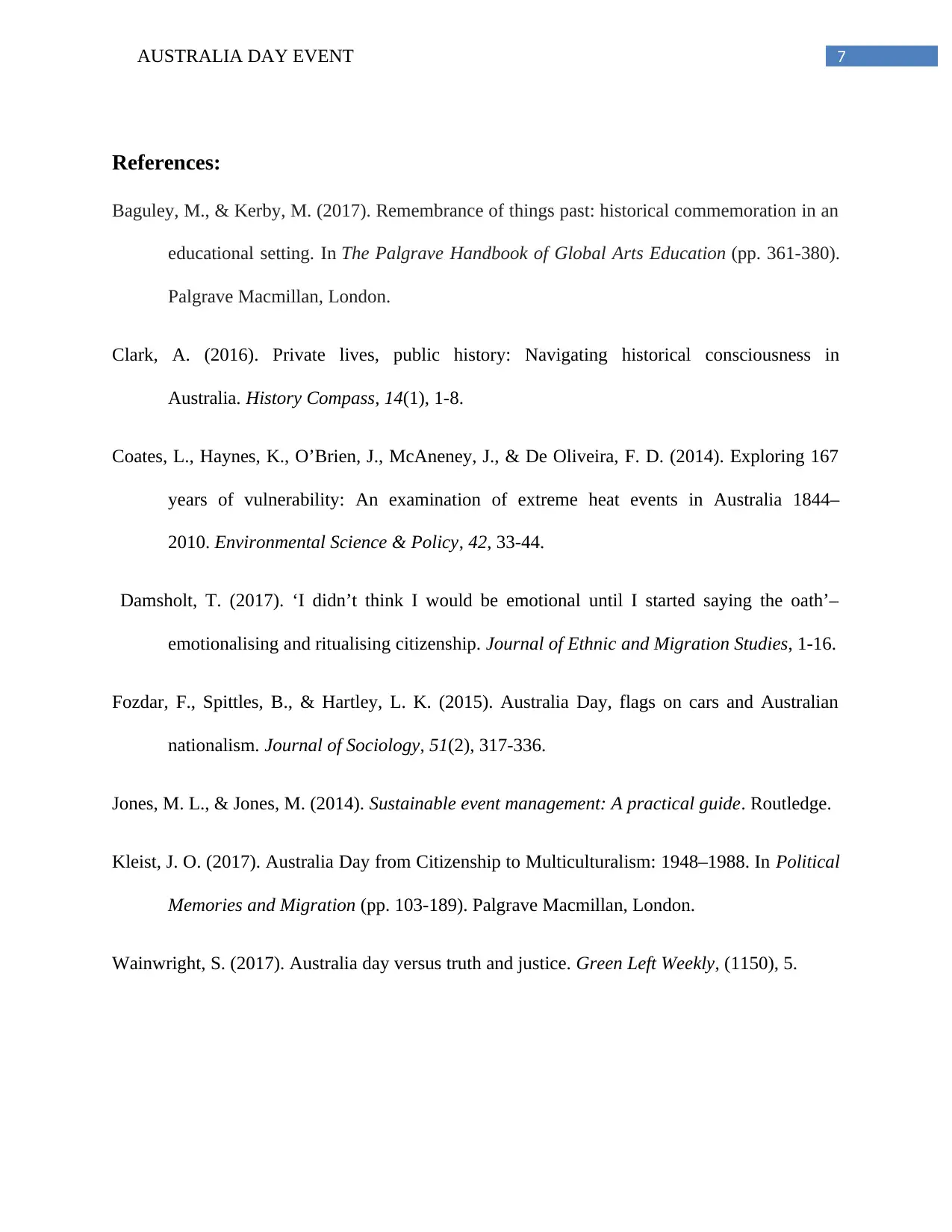
7AUSTRALIA DAY EVENT
References:
Baguley, M., & Kerby, M. (2017). Remembrance of things past: historical commemoration in an
educational setting. In The Palgrave Handbook of Global Arts Education (pp. 361-380).
Palgrave Macmillan, London.
Clark, A. (2016). Private lives, public history: Navigating historical consciousness in
Australia. History Compass, 14(1), 1-8.
Coates, L., Haynes, K., O’Brien, J., McAneney, J., & De Oliveira, F. D. (2014). Exploring 167
years of vulnerability: An examination of extreme heat events in Australia 1844–
2010. Environmental Science & Policy, 42, 33-44.
Damsholt, T. (2017). ‘I didn’t think I would be emotional until I started saying the oath’–
emotionalising and ritualising citizenship. Journal of Ethnic and Migration Studies, 1-16.
Fozdar, F., Spittles, B., & Hartley, L. K. (2015). Australia Day, flags on cars and Australian
nationalism. Journal of Sociology, 51(2), 317-336.
Jones, M. L., & Jones, M. (2014). Sustainable event management: A practical guide. Routledge.
Kleist, J. O. (2017). Australia Day from Citizenship to Multiculturalism: 1948–1988. In Political
Memories and Migration (pp. 103-189). Palgrave Macmillan, London.
Wainwright, S. (2017). Australia day versus truth and justice. Green Left Weekly, (1150), 5.
References:
Baguley, M., & Kerby, M. (2017). Remembrance of things past: historical commemoration in an
educational setting. In The Palgrave Handbook of Global Arts Education (pp. 361-380).
Palgrave Macmillan, London.
Clark, A. (2016). Private lives, public history: Navigating historical consciousness in
Australia. History Compass, 14(1), 1-8.
Coates, L., Haynes, K., O’Brien, J., McAneney, J., & De Oliveira, F. D. (2014). Exploring 167
years of vulnerability: An examination of extreme heat events in Australia 1844–
2010. Environmental Science & Policy, 42, 33-44.
Damsholt, T. (2017). ‘I didn’t think I would be emotional until I started saying the oath’–
emotionalising and ritualising citizenship. Journal of Ethnic and Migration Studies, 1-16.
Fozdar, F., Spittles, B., & Hartley, L. K. (2015). Australia Day, flags on cars and Australian
nationalism. Journal of Sociology, 51(2), 317-336.
Jones, M. L., & Jones, M. (2014). Sustainable event management: A practical guide. Routledge.
Kleist, J. O. (2017). Australia Day from Citizenship to Multiculturalism: 1948–1988. In Political
Memories and Migration (pp. 103-189). Palgrave Macmillan, London.
Wainwright, S. (2017). Australia day versus truth and justice. Green Left Weekly, (1150), 5.
1 out of 8
Related Documents
Your All-in-One AI-Powered Toolkit for Academic Success.
+13062052269
info@desklib.com
Available 24*7 on WhatsApp / Email
![[object Object]](/_next/static/media/star-bottom.7253800d.svg)
Unlock your academic potential
Copyright © 2020–2025 A2Z Services. All Rights Reserved. Developed and managed by ZUCOL.





